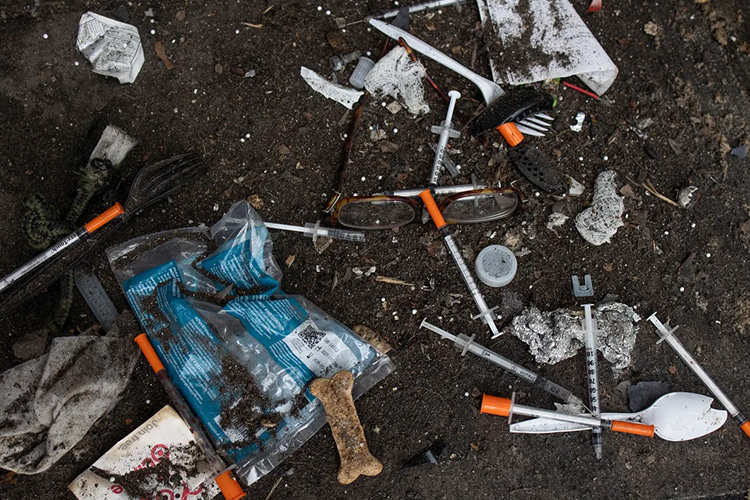
Xylazine has been found in one out of every nine fentanyl related overdoses nationwide, according to the CDC. photo courtesy of Andrew Lichtenstein
The fentanyl crisis in the U.S. is being exacerbated by xylazine, a potent sedative used in veterinary medicine.
In Kensington, Philadelphia, a neighborhood known for its rampant drug use, the cheap and potent sedative xylazine, referred to as tranq, is being mixed into illicit substances such as fentanyl and heroin. The internet has deemed xylazine as the “Zombie Drug” because users suffer from flesh rotting wounds and dangerously slow heart rates. Although tranq has been detected in 90% of dope samples in Philadelphia, the drug’s widespread epidemic poses threats to much of the United States as well.
Xylazine is an FDA-approved sedative intended only for veterinary use. In the United States, it’s used in surgical procedures to sedate animals such as cattle, sheep, horses, and deer. However, when humans are exposed to xylazine, they experience a unique set of life-threatening symptoms: blurred vision, disorientation, drowsiness, staggering, coma, and respiratory depression as well as lowered blood pressure and heart rate. In an interview with PIX11 news, opiate user and Kensington resident Art El Malik admitted that he’s aware of the risk of infection associated with xylazine. “A lot of my friends have lost their limbs already,” explained Malik. However, unlike Malik, many opiate users outside of Philadelphia are entirely unaware when they’re being exposed to “tranq,” adding another layer of complexity to this epidemic.
Xylazine is being used as an adulterant in common narcotics such as cocaine, fentanyl, and heroin, largely due to its low cost and low risk of legal repercussion since it has not yet been classified as a controlled substance. When purchased legally through pharmaceutical distributors, solutions of xylazine are carefully concentrated according to the size of species it is intended to sedate. However, according to the Drug Enforcement Agency (DEA), “a kilogram of Xylazine powder can be purchased online from Chinese suppliers with common prices ranging from $6-$20 U.S. dollars per kilogram.” When mixed with opiates, the psychoactive effects of xylazine amplify and extend the effects for the user. Illegal drug traffickers take advantage of this effect, allowing them to dilute their product, thus increasing their overall profits. Cartels, such as the Sinaloa Cartel, are responsible for purchasing xylazine from China and mixing it in their narcotics.
Although xylazine is most prevalent in the Northeast and Southeast regions of the country, the DEA has seized xylazine and fentanyl mixtures in 48 out of 50 states. Since “tranq” is not classified as an opiate, the administration of Naloxone (Narcan) doesn’t reverse its lethal effects, drastically increasing the potential for an overdose. In the Northeast alone, xylazine-positive overdoses rose from 631 in 2020 to 1,281 in 2021, totaling an 103% increase. In this same time frame, the Southeast saw a 1,127% increase in xylazine related overdoses, followed by the Midwest and then the West. The U.S. DEA issued a warning on March 21, 2023 about an increase in trafficking of fentanyl-xylazine mixtures. The DEA also noted the importance of administering Narcan to victims of xylazine-opiate overdose. Although Narcan does not reverse the effects of xylazine, it will reverse the effects of fentanyl, increasing chances of survival.
Last July, the White House Office of National Drug Control Policy (ONDCP) released a National Response Plan to coordinate a response against the threat of xylazine. This plan is structured around six categories: testing, data collection, evidence-based prevention, supply reduction, scheduling, and research. The ONDCP aims for a 15% reduction in xylazine positive drugs by 2025 compared to data gathered in 2022. Ultimately, xylazine poisoning will continue to pose a threat to our country unless the drug is classified as a controlled substance.